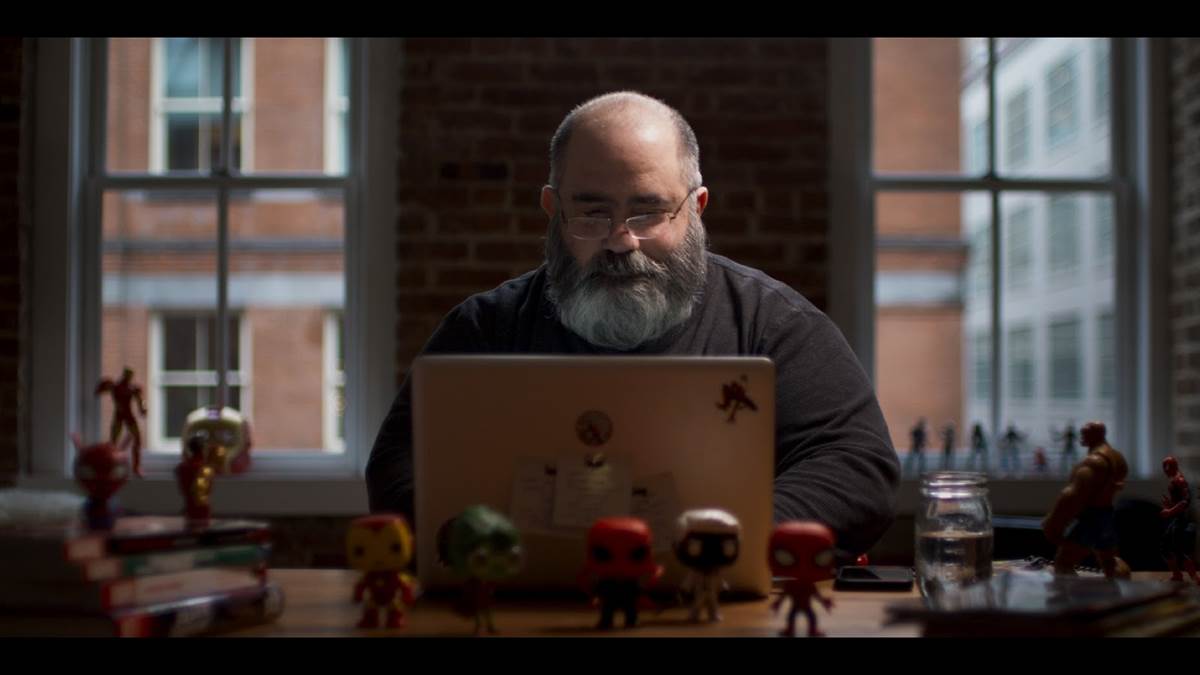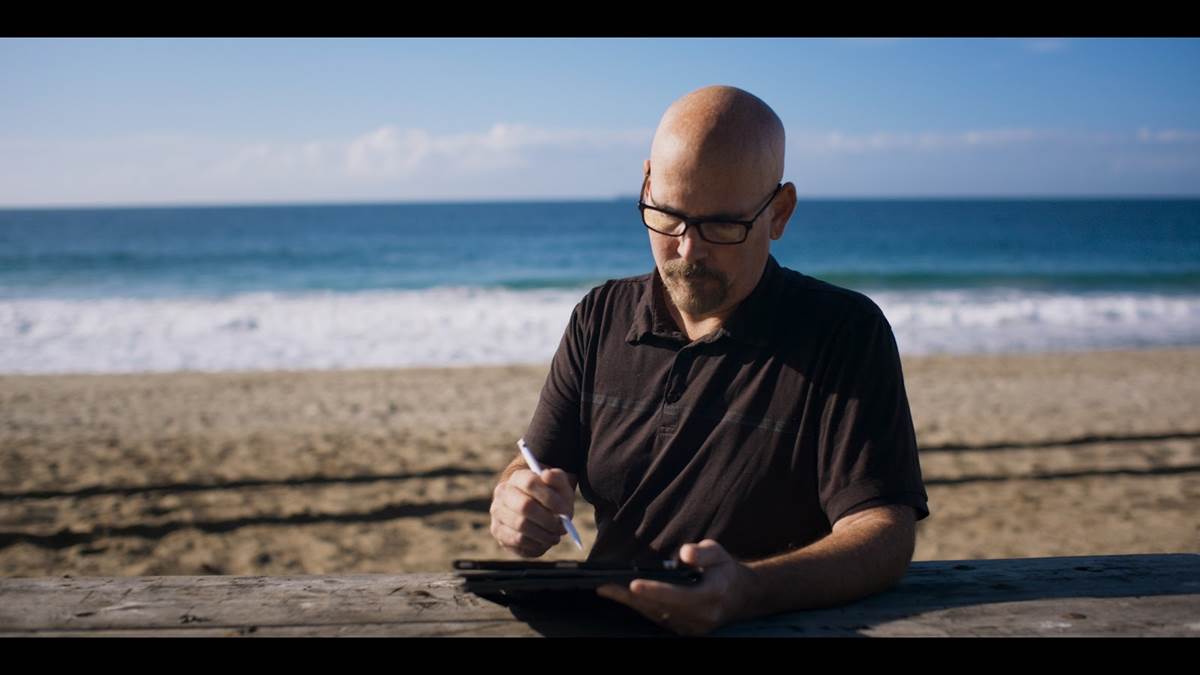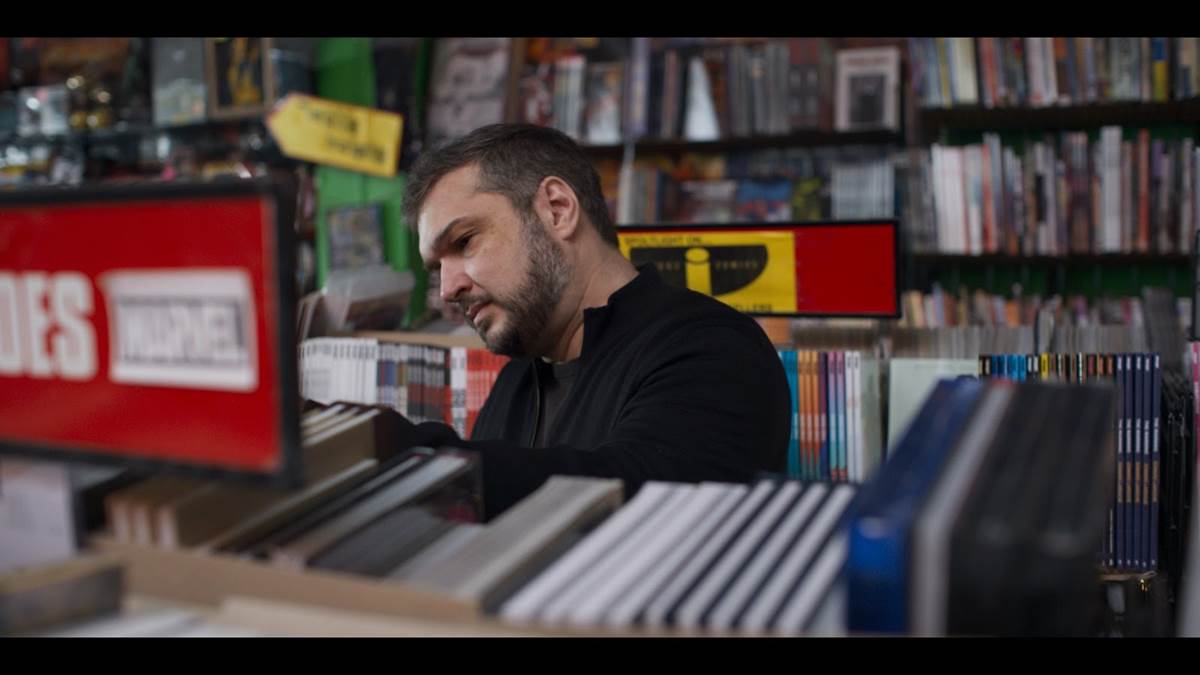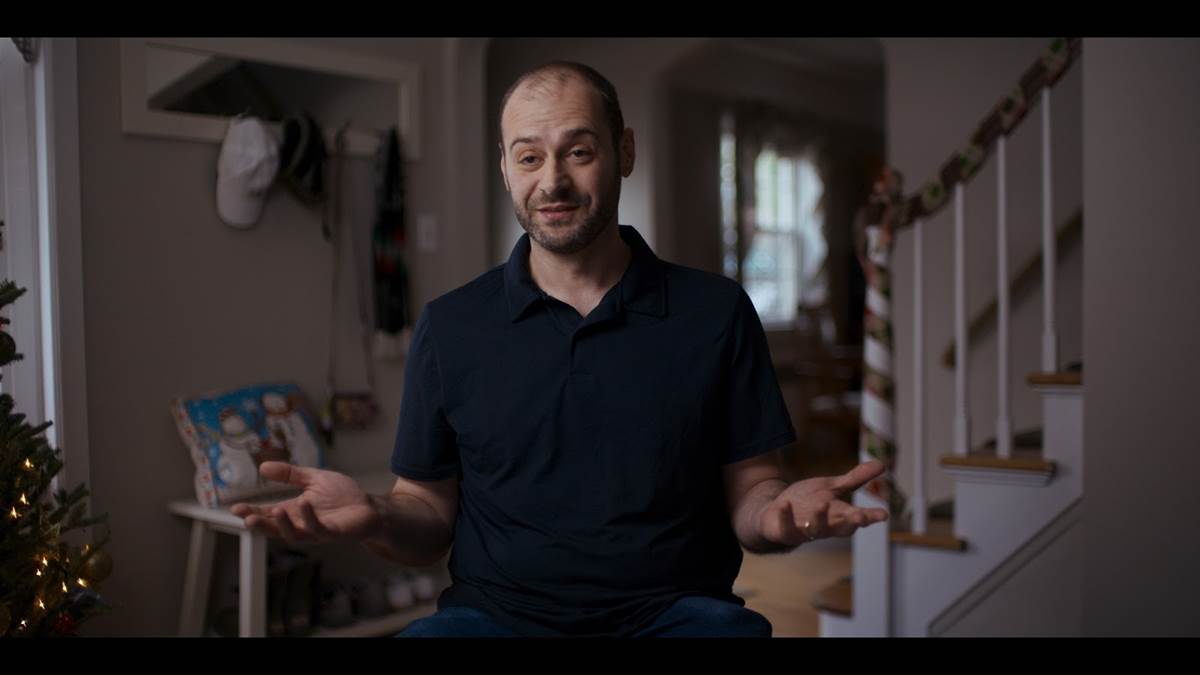Marvel’s 616, a brand new series on Disney+, explores Marvel’s rich history by going way beyond the stories and character everyone already knows and loves. Eight different filmmakers take a deep dive into completely unique Marvel stories that interest them.
The seventh episode, directed by Brian Oakes, takes a look at just how Marvel Comics are made. The episode, titled “The Marvel Method,” follows writer Dan Slott, artist Pete Woods, Marvel editor Tom Brevoort and more as they come together to create “Iron Man 2020.”
The episode opens with Slott attempting to begin his writing process on “Iron Man 2020 #1.” In a very funny segment, we see Slott at his laptop struggling to come up with the script for this new comic as he deals with some writer’s block and distractions.
Slott mentions that Stan Lee would refer to Marvel as “the world outside your window,” stressing the importance of the fact that Marvel characters lived in the real world, namely New York City. Slott runs through a bit of his career history and how excited he is to work on Iron Man 2020.
Slott arrives at a comic shop where he explains that, since it is almost 2020 (the episode was shot in 2019), they are rebooting Iron Man 2020, a comic series originally written in the 80s. He jokes that the year 2020 was chosen because it was “a crazy future year that we would never, ever reach.” Now, he’s excited to be the one writing “Iron Man 2020” in the year 2020.
Next, he heads to the Marvel Comic Headquarters to meet with editor Tom Brevoort, who talks a bit about his career. The two plan out this new comic and Brevoort jokes that he’s sure Slott has a lot of ideas and nothing actually put together. He explains that Slott is terrible with deadlines, a surprising thing to learn about a comic writer as successful as he is.
We return to Slott’s desk, where he continues to struggle to work on the first page of his new comic. We watch as he hilarious makes typos and becomes frustrated over what he’s writing. As a writer, nothing in this series has been more relatable.
We then get a bit of a history lesson on Marvel and their classic method for writing comics. Larry Hama, writer and editor at Marvel, joins in to explain that in the beginning there was the DC method and the Marvel method to writing comics. Most comics would be made off of a full script, with the artist filling in the blanks. Marvel used a different system, in which the writer would come up with a brief description and the artist would lay out the whole page and how the story plays out. Then, the writer would get the art back and add the dialogue. This became the Marvel method.
Today though, the Marvel method isn’t really used. Slott explains that he is one of the last few writers still following the method, as most actually create a full script. Slott explains that he likes the other creators to be able to have some freedom and take the story where they see it going.
He goes on to explain that, when it comes to comic book art, you normally have a whole team of artists putting it together. A penciller lays out the whole book, an inker embellishes it and finally a colorist adds all the color. In the case of “Iron Man 2020” though, Pete Woods handles all of those responsibilities.
We then meet Woods in his van in Malibu. As he works on the beach, he explains that technology allows him to draw wherever he wants to draw. He goes on to explain that he likes having some stake in the storytelling and he begins going to work on the character’s design while waiting for a panel-by-panel breakdown from Slott.
We rejoin Slott as he begins to explain the story of “Iron Man 2020” and maps everything out in his head. Those thought become literally illustrated above his head, which shows just how hectic and wild things can get inside the head of a comic writer. He admits that he realizes all of these crazy ideas he has will result in painstaking labor from Woods.
Slott begins to describe a giant creature as the episode pans back to Woods, who immediately goes to work on it. Woods explains that he likes the Marvel method because it allows the writer and artist to work together more in tandem and gives him more input into the story. As he draws this new creature, he explains that he needs to make it unlike anything we’ve ever seen before.
We then jump back to the MArvel Headquarters with Brevoort, who explains that the Marvel method was created because Stan Lee didn’t have enough time to write full scripts. He then goes into a classic story, in which a mysterious new character showed up in one of Lee’s comics when artist Jack Kirby decided to add him in on his own. When Lee questioned Kirby about the character, he explained his backstory and that he fit in with current pop culture. That was the creation of the Silver Surfer.
We rejoin Slott who is looking over some of Woods’ initial sketches for the new comic. He is blown away by the design of the massive creature but is not thrilled with the design of Iron Man himself. He reads a text from Woods saying that he doesn’t like the gears, the signature look of Iron Man 2020. Slott gives Woods some notes and tells him they have to have the gears. We cut back to Woods who decides to lean into the gears and actually ends up making them even bigger than before.
Back at headquarters, Brevoort explains that he oversees the work of various junior editors at Marvel, including Shannon Ballesteros, who is editing “Iron Man 2020.” Ballesteros talks through the process of editing a comic, from concept to printing.
Back at Slott’s desk, he continues to struggle to write the first issue. He explains that writer’s block will often stem from the writer’s inner critic saying “this isn’t good enough.” He then brings up the idea of the negative impact of social media as he tells the story of when he killed Spider-Man in one of his comics. We see an array of social media posts from angry fans lashing out at Slott as he explains that he wants everything to be perfect as he puts it on the page.
Back at headquarters, Brevoort explains that Slott is behind schedule on the new comic so he decides to bring in Christos Gage, another writer, to handle the dialogue. Slott jokes that Gage is the other half of his brain and Gage explains that he is Slott’s deadline helper. With Gage on board, the team starts to bring this new comic together.
Gage gets the story from Slott and the art from Woods and begins to go to work on dialogue. We get to see the collaboration process between Gage and Slott as they go back and forth on how certain characters should be speaking. Strangely enough, the biggest contention point is exactly what a talking cat would sound like.
We rejoin Woods, who has completed the inking stage of his artwork for the comic and is ready to begin adding color. He explains that a lot has changed over the years in the world of creating comics. There’s a lot more editorial direction now and a plan that covers the whole Marvel Universe.
That starts up a conversation about the idea that the days of artists creating characters, like Kirby creating Silver Surfer, are done. Gage explains that editors would never approve a plot as loose as the one that got to Kirby’s death because it is unfair to the artist to expect them to come up with so much of the story. Brevoort explains that Slott is one of the last who still uses the Marvel method because he started so long ago, but since Marvel has become such a huge multimedia brand, that method is no longer effective.
We then see Gage working on his portion of the new comic. He creates the dialogue for the massive new creature Woods created and we see the story coming together. Gage restates that, with the Marvel method, the comic becomes more of a collaboration.
We’re then introduced to letterer Joe Caarmagna. Slott notes that letterers are the unsung heroes of comic creation. Caramagna explains that, when working with Slott, he typically has to wait longer for scripts and that he usually gets them about two days before the book has to go to press. We also get to see Caramagna work as Slott explains that a letterer lays out the flow of text in the comic, essentially directing the readers’ eyes from one panel to the next.
We then get back to Slott’s desk where he talks out more ideas, in his head. We also get a peek inside Woods’ head as he talks through character designs and Gage’s head as he talks through more dialogue. The team works feverishly to get the book done before their deadline.
We then head to a print shop in Mechanicsburg, Pennsylvania where Marvel Comics are printed. Jim Boyle, VP publishing operations at Marvel, talks us through a bit of the printing process. Ballesteros explains that they’re now in the final stage of the process as she scans for any mistakes and send notes back to Caramagna.
The letterer explains that he will sometimes be getting notes back up to 15 minutes before the deadline. Caramagna finishes up on his last batch of edits and submits the comic to the printer. We then get to see some really cool shots of the comic being printed and flying through all of the machinery as it gets ready to be shipped out to comic shops.
Slott signs copies of the new comic for fans at a comic shop in New York. Several of those fans get in front of the camera and talk about their histories with comics and how much Slott’s work has meant to them.
As the episode comes to a close, Slott refers to comics as the greatest medium in the world. Ballesteros mentions how amazing it is to see fans engaging with something they’ve created. We also get to see a clip of an interview with Stan Lee talking about working with artists and seeing his words become a real story. Finally, as Slott expresses his relief in the first issue being done, Brevoort jokes that he now only has to do it five more times.
You can learn more about Marvel’s 616 and see recaps of each episode here. All eight episodes of Marvel’s 616 are streaming now on Disney+.






